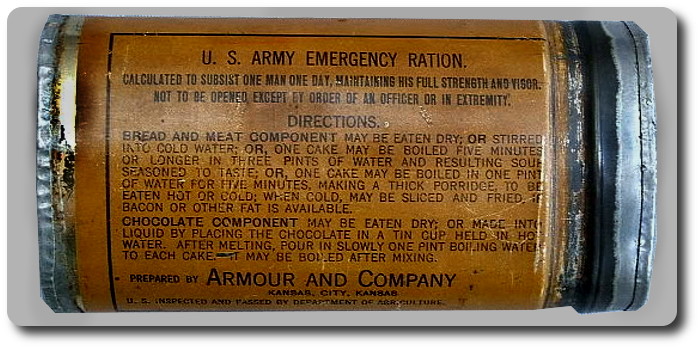Topic: Army Rations

The Food of Armies (1918)
Some Strange Looking Specimens of Highly Concentrated Rations Prepared for the Nourishment of Soldiers on the Trenches and on the Battlefield
Coffee, tea, chocolate, cocoa, and so on, are indispensable, and in some armies, such as the French, light wine is furnished as part of the regular diet of the soldier. The Germans prefer beer.
The Spokesman-Review, Spokane Washington, 12 January 1918
As long as an army is fed it can fight, provided, of course, that its guns are fed also. We hear more about the food of the guns than about that of the men, but the latter is the more important of the two, as was shown recently when come of our boys in France, having no guns, fought their way out of German captivity with their fists.
The improvements in army food also keep step with those in powder and projectiles. High-powered powder and high-concentration foods are the twin winners of modern battles. Some of the foods used as "emergency rations" are curious indeed, and some possess astonishing powers of nourishment locked up in a very small space. Modern improvements and discoveries in the preservation and concentration of foods have, perhaps, been as effective in extending the range of military campaigns, accelerating the rapidity of strategic movements and increasing the power of sudden blows as any advance in armament.
Meat stands, as it always has done, at the head of the list of essential foods for an army. Bread, in its various forms, comes next. Fruits and vegetables must generally be furnished in preserved and concentrated forms in which shape they supply some of the sugar, which is a very essential element of an army's rations. Coffee, tea, chocolate, cocoa, and so on, are indispensable, and in some armies, such as the French, light wine is furnished as part of the regular diet of the soldier. The Germans prefer beer.
It is asserted that tea is the most sustaining of all the army beverages because it is especially effective in arresting waste of the bodily tissues. It ranks next to milk in this quality. The Russians are the great tea drinkers, and the English are fond of it, but it has never had the popularity of coffee with American men. The Russian army has many forms of compressed tea in its rations, and it is averred that the Russian soldier could hardly fight without tea. One of the illustrations shows a round disk of compressed tea for the Russian army made of whole leaves of prime quality, and weighing three pounds, yet not too large to be slipped into a coat pocket. Other forms in which the tea is preserved are bars, slabs, and balls.
There is an emergency meat ration called the "chain-shot ration" on account of its form. It is used by the Belgians, French and Germans as a winter ration, being too oily for summer use, and L. Lodian says of it in the Scientific American that it "is the finest combination of sustaining and heating qualities known among the meat foods." Each ball is a chain constitutes one complete ration.
But the celebrated "pea-sausage," or erbswurst," of the German army gets a setback on the same authority, for it is said to be "about as unsatisfactory a concentrated ration as any extant, and is actually inedible when uncooked, being of a nauseating, bitter and raw flavor."
The notable ration of the Swiss army is "white chocolate," which consists of nothing but cocoa butter and sugar, the brown parts of the cocoa being removed. Moulded into a cake it resembles in color and gloss a billiard ball. It is more nutritious than brown chocolate.
The emergency ration of our own army, as prepared for the trenches, consists of chocolate tablets and packets of parched cornmeal. The latter seems to have been suggested by the parched corn of the Indians who often, when on the warpath and compelled to undergo great fatigues, subsisted for days on this food alone. Still, as a ration, the pemmican which some of the American tribes ultimately adopted, is said to be much superior in sustaining power to the cornmeal, or any other cereal food, since it contained chopped meat together with grain.
The Italian rations contain chocolate stuffed in sausage-like cases and a kind of plum duff, stuffed with raisins, and inclosed in a long membrane, in which it can be cooked with steam, while the empty case will serve for a tobacco pouch.
The Italian duff is said to be more nourishing than the British plum pudding. A kind of "spotted dog" is prepared with dark Italian wines instead of water, while rich nut meats are used for shortening. This recalls the rye hardtack of the Russians, in the making of which beef blood is emplyed instead of water.
But the nearest approach to the ideal emergency ration is said to be "the unsalted, sun-dried, paper-thin meat sheets" issued to some of the Latin American armies. It can be folded up and pocketed like paper, and is ready to be eaten withour preparation of cooking. Similar sun-dried meats in sheets are used by the soldiers of some Asiatic and African tribes.

